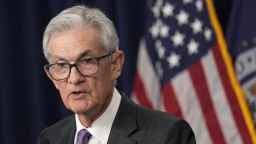LondonCNN —
The US economy’s standout performance will be a major driver of global growth this year but could make America’s inflation problem harder to solve, according to the International Monetary Fund.
The IMF upgraded Tuesday its forecast for US economic growth to 2.7% this year — 0.6 percentage points higher than it predicted as recently as January.
The move highlights how the United States is outpacing other advanced economies, notably the European economy, which has struggled to regain momentum after the pandemic, with high interest rates and the lingering effects of earlier rises in energy costs weighing on activity.
The Washington-based IMF expects the 20 countries that use the euro to grow just 0.8% this year, a downgrade of 0.1 percentage points from its January forecast.
The global economy, meanwhile, is seen expanding by 3.2%, 0.1 percentage points more than predicted in January. China’s economy, the second-largest in the world, is forecast to grow 4.6%, while India is expected to notch growth of 6.8%.
https://ix.cnn.io/charts/Pn5H6/?initialWidth=910&childId=graphic-Pn5H6&parentTitle=US%20economy%3A%20IMF%20raises%20growth%20forecast%20and%20urges%20caution%20on%20rate%20cuts%20%7C%20CNN%20Business&parentUrl=https%3A%2F%2Fedition.cnn.com%2F2024%2F04%2F16%2Feconomy%2Fimf-us-economy-growth-inflation-warning%2Findex.html
“The strong recent performance of the United States reflects robust productivity and employment growth, but also strong demand in an economy that remains overheated,” IMF chief economist Pierre-Olivier Gourinchas wrote in a blog post accompanying the agency’s World Economic Outlook. “This calls for a cautious and gradual approach to (monetary) easing by the Federal Reserve.”
“Astonishingly, the US economy has already surged past its pre-pandemic (growth) trend,” Gourinchas added in the foreword to the report.
Annual US inflation has ticked up in recent months after falling considerably from a peak of 9.1% hit in June 2022. Consumer prices rose by a stronger-than-expected 3.5% in March, prompting traders to postpone expectations of the first interest rate cut by the Fed by several months.
An economy can overheat when rapid economic growth — often triggered by a sudden increase in household and government spending, as has happened in the United States — causes inflation to rise.

RELATED ARTICLEThe Fed might not be done raising interest rates just yet
What’s more — although it’s not their central forecast — strategists at UBS now see “real risk” that the Fed won’t cut borrowing costs and rather will resume raising rates by early next year, according to a recent note. Some Fed officials have recently argued in favor of keeping rates on hold for the remainder of this year.
Also posing upside risks to inflation are high government spending and debt levels in the United States. “The fiscal stance… is of particular concern,” Gourinchas wrote. The IMF said in its report that the country’s fiscal approach raises short-term risks to the process of slowing inflation, “as well as longer-term fiscal and financial stability risks for the global economy since it risks pushing up global funding costs.”
In contrast to the United States, “there is little evidence of overheating” in the euro area, according to Gourinchas.
The European Central Bank will need to “carefully calibrate the pivot toward monetary easing” to avoid inflation — currently at 2.4% — falling below its 2% target, he added.
Inflation not beaten yet
The IMF expects inflation to average 5.9% around the world this year, down from an average of 6.8% in 2023 but 0.1 percentage points above its January forecast.
“Worryingly, progress toward inflation targets has somewhat stalled since the beginning of the year,” Gourinchas wrote.
Inflation has been dampened by lower energy costs and slower rises in goods prices as supply chain frictions have eased and Chinese export prices have fallen. But “stubbornly high” inflation in the cost of services and a recent increase in oil prices, in part due to escalating tensions in the Middle East, could push overall prices higher again, Gourinchas said.

RELATED ARTICLEChina’s economy expands by a surprisingly strong pace in the first quarter of 2024
“Further trade restrictions on Chinese exports could also push up goods inflation,” he added.
Officials in Europe and the United States have voiced concerns about potential “dumping” by China — that is, the export of goods at artificially low prices. That raises the prospect of tariffs on certain Chinese products, which could lift broader inflation.
China, the world’s biggest manufacturer, could also become the source of a different risk to global inflation, via stronger-than-expected economic growth. China’s economy expanded 5.3% in the first quarter, according to official figures published Tuesday, beating estimates of economists polled by Reuters.
In a sign of the threat to inflation, the data, which reflected a jump in high-tech manufacturing, gave some support to oil prices Tuesday.